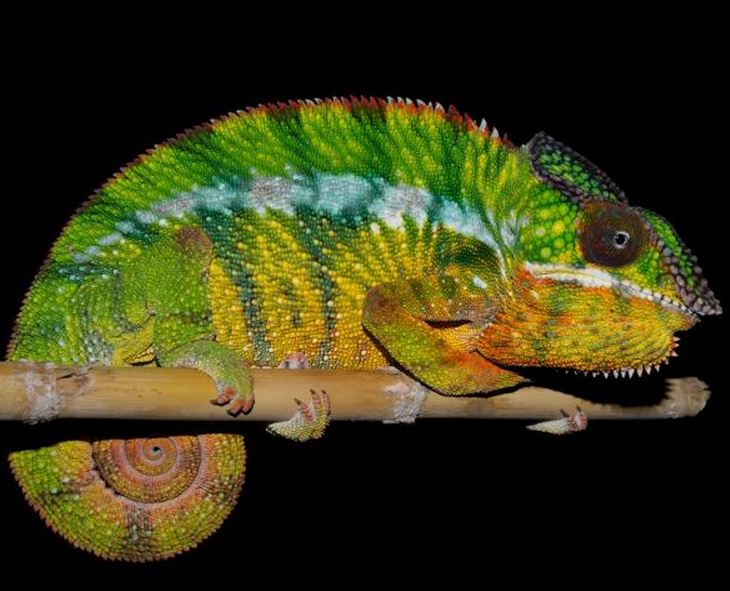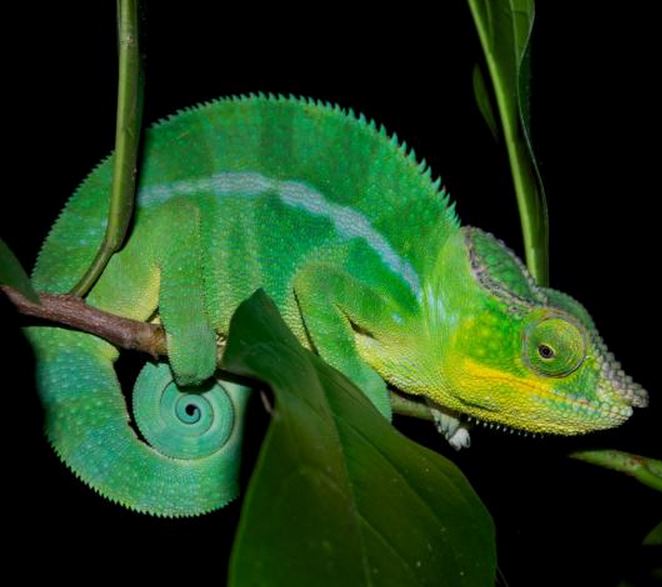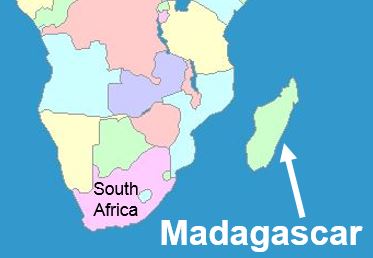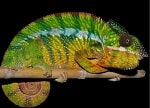The Panther chameleon, which is native to Madagascar, is composed of eleven different species and not just one as previously thought, scientists from Switzerland and Madagascar discovered in a new study.
Madagascar, home to an incredible biodiversity, has over the past two decades come under enormous attack from deforestation, which is undermining the survival of hundreds of species of animals and plants, including the Panther chameleon.
The panther chameleon (Furcifer pardalis) can be found in the tropical forests of eastern and northern parts of Madagascar. It has also been introduced to Mauritius and Réunion. It is a species with spectacular intra-specific colour variation.
 Panther chameleon (Furcifer pardalis). (Image: Eurekalert. Credit: Michel Milinkovitch)
Panther chameleon (Furcifer pardalis). (Image: Eurekalert. Credit: Michel Milinkovitch)
One becomes eleven
A new study led by Michel Milinkovitch, professor of genetics, evolution and biophysics at the University of Geneva (UNIGE) in Switzerland, together with researchers in Madagascar, found that this charismatic reptile is actually made up of 11 different species.
The scientists wrote about their findings in the academic journal Molecular Ecology. They also wrote about the importance and urgency of protecting the island’s habitats.
Swiss scientists, together with professor Achille Raselimanana of the University of Antananarivo, Madagascar, set out to find the genetic keys behind Furcifer pardalis’ amazing colour palette.
A Talkative Drop of Blood
The researchers collected a drop of blood from each of 324 individuals during two expeditions from East to West. They documented the samples through colour photographs.
 Another Panther Chameleon. (Image: Eurekalert. Credit: Michel Milinkovitch)
Another Panther Chameleon. (Image: Eurekalert. Credit: Michel Milinkovitch)
The DNA (mitochondrial, nuclear) of each specimen was analyzed and sequenced in the lab according to the hypothesis that a chameleon’s dominant colour could be related to the geographic zone where it was found.
The genetic material suggested strong genetic structure among the geographically-bound lineages, revealing minimal interbreeding among populations.
A Key for Turning Genetics into Color
The scientists carried out mathematical analyses of the 324 colour photographs and found subtle colour patterns, confirming that many of the geographical populations may need to be considered as separate species.
The researchers then simplified their analyses of the colour diversity into a classification key, which allowed them to link most chameleons to their corresponding species using just the naked eye.
 Most of Madagascar’s wildlife exists nowhere else on Earth.
Most of Madagascar’s wildlife exists nowhere else on Earth.
The authors wrote:
“This case of hidden speciation confirms a major characteristic of Madagascar: it is amongst the most diverse places for life on Earth; a biodiversity hotspot.”
Each new chameleon species needs to be managed individually, given that they come from different parts of the whole biodiversity.
The researchers’ visual classification key could help local biologists and trade managers avoid local population over-harvesting.
Madagascar’s forests under threat
Madagascar has an enormous task to protect its biodiversity. Much of its forests are being destroyed to make way for farmland, as well as firewood and charcoal production by populations with very low living standards and few other options to earn their living.
Madagascar’s human activities threaten the survival of over 400 types of reptiles, 300 species of amphibians and 300 kinds of birds, as well as 15,000 species of plants and a huge number of invertebrates.
Between 80% and 90% of all Madagascar’s living species are unique to the island, i.e. they exist nowhere else.
Prof. Milinkovitch hopes this study will help raise awareness regarding the “staggering but fragile biodiversity hosted by Madagascar.”
Citation: “Phylogeography and support vector machine classification of colour variation in panther chameleons,” Djordje Grbic, Suzanne V. Saenko, Toky M. Randriamoria, Adrien Debry, Achille P. Raselimanana and Michel C. Milinkovitch. Molecular Biology. Published 24 May, 2015. DOI: 10.1111/mec.13241.

